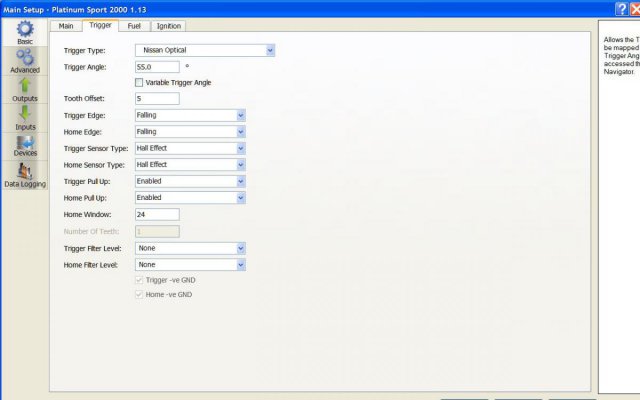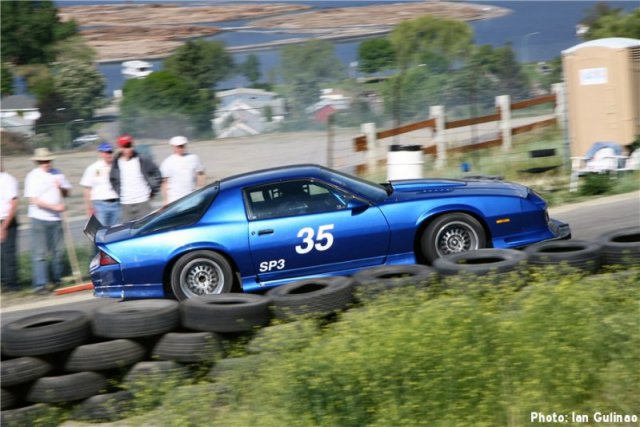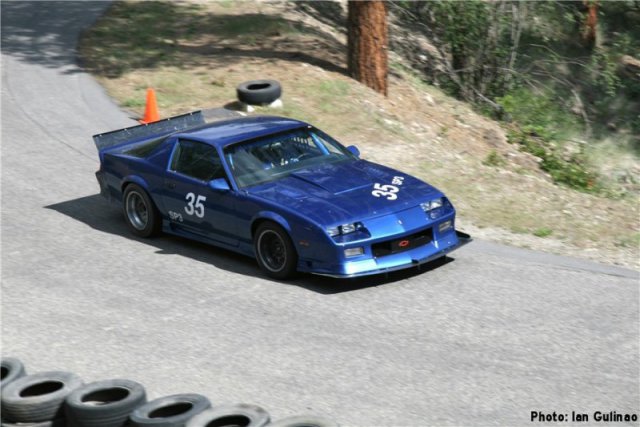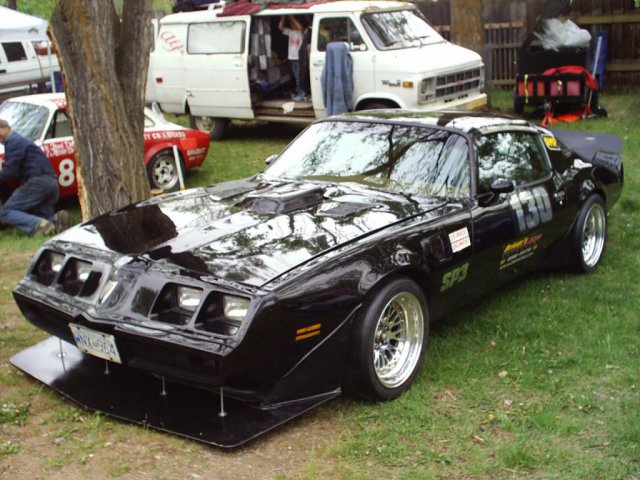-
Posts
1051 -
Joined
-
Last visited
-
Days Won
9
Content Type
Profiles
Forums
Blogs
Events
Gallery
Downloads
Store
Everything posted by Chickenman
-
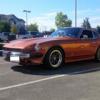
Weber jets??All who live for their triples please read this
Chickenman replied to datfreak's topic in Nissan L6 Forum
I'll have to respectfully disagree with that Steve. Please bear in mind that this method of Ignition tuning greatly affects modified engines with larger overlap cams. The bigger the overlap, the more timing that is required. A 280 degrees cam typically needs 25 degrees at idle. a 290 cam as much as 30 degrees. For street drive-abilty. I explained the reasons why ( Low mixture density and Camshaft EGR effect ). How this affects Weber tuning is that the extra advance at idle only ( and that is the key part ) results in less of a throttle blade opening. And that puts the Throttle Blade to progression holes in the correct position. If you can't get the Throttle blade position right then you can't tune your carbs properly. You can't realistically just set your static timing at 25 or 30 degrees for numerous reasons. A couple of obvious ones are that you will kill your starter motor quickly and you will have too much advance at low RPM's and part throttle or large throttle openings ( Mixture density increases and you will get detonation ) . So vacuum pot tuning is a sensible way to get the engine timing to where it needs to be and to decrease the Throttle Blade opening at idle, so that you aren't uncovering the Progression or Transition holes. I've used this method of Vacuum pot tuning tuning on many, many different carburated engines over the years. All with larger cams. The effects have always been positive. A more stable idle, a cleaner idle and a higher manifold vacuum generated. Those are all positive results and are solely a result of being able to get the Throttle Blade position correct. And that requires running an asymmetrical advance curve, which you cannot do with just a centrifugal advance by itself. Just my .02c -

Going crazy here, charging issue
Chickenman replied to lorenzo's topic in S30 Series - 240z, 260z, 280z
^ Yep.. I recently installed a 1985 Maxima 300ZX ( Mitsubishi 70 amp. ) IR alternator and Voltage is much more stable now. Idle output amperage on these newer alternators is increased substantially over the earlier models. 14.35 Volts at idle and 14.55 volts at 2,000 rpm. Rock steady!! I can have lights, wipers, stereo and defrost on full blast and no drop in Voltage at idle any more. Even the previous 60 amp 280Z alternator ( External Reg ) couldn't mange that. . I feel much more confident taking the 280Z on long trips now. -

Weber jets??All who live for their triples please read this
Chickenman replied to datfreak's topic in Nissan L6 Forum
Yes, as you mentioned, the positioning of the throttle plates in regards to the progression holes is very important to getting a smooth idle and it also affects tip in as you also mentioned. The pictures tell a thousand words. -

Going crazy here, charging issue
Chickenman replied to lorenzo's topic in S30 Series - 240z, 260z, 280z
Are the no charge light illuminated and the Brake warning light on...even with the handbrake released? If so check out the following. It's a weird one.... Fuse block. Lower right hand corner. There is a fuse marked 1 amp for Floor Temp lamp. If this fuse is blown you will get a no charge situation. Thing is this circuit is used for non-Catalyst cars ( Canadian and Federal models ) as well as Catalytic( California ) models. This circuit also ties in with the Brake check relay and the Charging relay located inside the V/Reg. If this fuse is blown.... no chargy. Another point. The fuse amperage rating seems to be wrong. No way is it a 1amp. I have a 10 amp fuse in there and it would occasionally blow when the V/Reg acted up. A 1 amp fuse blew as soon as I inserted it. Picture of 1976 Fuse cover. Fuse in question is in lower right corner. -

Weber jets??All who live for their triples please read this
Chickenman replied to datfreak's topic in Nissan L6 Forum
The idle mixture adjustment screws should not be significantly affected by changing the the Idle jets...if at all. Idle jets are more correctly called low speed jets as they mainly affect off idle fuel mixture up until the mains start coming in. There will be some overlap, but minimal. Having the throttle blade uncovering too much of the progression hole is the #1 problem of having too rich of an idle. Independent runner carbs, particularly with larger Camshafts, need a LOT of static ignition timing. 15 - 17 degrees BTDC minimum set on the dizzy at idle. Better yet. Hook up the Vacuum advance to manifold Vacuum and add another 10 degrees of Vacuum advance at idle. Yes that is a total of 25 degrees advance at idle. If you can hook up a balance pipe system to run manifold vacuum to the Vacuum advance it makes an amazing difference to the idle quality. That allows the throttle blades to be closed more at idle and makes the isle screws much more responsive. A lot of sites advocate disconnecting the Vacuum advance when running IR crabs. That works fine on Race cars that are run on a race track. However, it is a bad idea on a hot rodded Daily Driver. It adversely affects fuel mileage, idle quality and low speed drive-abilty. David Vizard has an excellent book called " Performance with Economy ", where he explains the importance of running a Vacuum advance on modified street car. It's well worth ordering this book. Cam overlap greatly reduces VE and also provides a natural EGR at idle. Because of the closed throttle blades ,VE is very low and that creates a low density mixture in the cylinder. Dynamic compression ratio is reduced. Commonly by 30% or more. So a calculated 10 to 1 CR actually is more like 7 to 1 or less. ( That's why when taking a Compression Test the instructions always recommend jamming the Throttle Blades wide open ). This low density mixture takes longer to burn. Thus you need more advance to light things off sooner. Overlap on larger cams needs more ignition advance. Then there is the EGR affect of larger overlap cams. Factory stock EGR is normally turned off at idle, because it dilutes the mixture too much. But you can't turn of EGR generated by the extra valve overlap of a larger Camshaft. So you have further reduction in density of the Air/Fuel mixture and pollution of the AF mix by exhaust gases. And that requires even MORE ignition timing at idle. A hot rodded engine wants 25 to 30 degrees of Total advance at idle in an ideal situation. An adjustable vacuum pot is one way to get this. Fortunately the Nissan Matchbox dizzy's do have an adjustable Vacuum pot. Both in stroke and spring tension. Set static ignition timing to 15 degrees BTDC ( vacuum hose disconnected ) Then hook the Vacuum advance up to manifold vacuum. Biggest problem with IR carbs is that you need a balance pipe system to draw vacuum from all four ( or six ) manifold legs. You can't just pull the Vacuum off of one manifold leg. Cylinder pulses are to strong and pulsating on the IR design. Another reason why most guys don't run a Vacuum advance with duals or triples. But it's a mistake ( for drive-abilty ) on a DD. Adjust the Vacuum pot stroke so that you have about 10 degrees of additional advance. Loosen the spring tension so that the rod pulls all the way in at a lower setting than stock. I use a mighty vac for this. I usually set a cammed engine so that the rod pulls in all the way with only 10 hg of Vacuum. Check out Jason Greys article on tuning Datsun dizzy's and Vacuum pots. . http://newprotest.org/projects/510/jasonGrayDistributor.pl Here's a very good thread on Weber Tuning on " The510realm". Some very good info there. Including a few suggestions from your's truly. http://the510realm.com/viewtopic.php?f=30&t=28635 Hope this helps. -
^ agreed. Or change the Trigger setup from Falling edge to Rising edge. That should correct for the change in Rotation direction. Then again the AEM 24 +1 trigger wheel works great as well. And it should be configured as a 24 Plus 1 ring... not a 24 minus 1 ring.... as per Haltech Software and Firmware revisions for Nissan RB enigines.
-

Weber jets??All who live for their triples please read this
Chickenman replied to datfreak's topic in Nissan L6 Forum
WOT AFR's of 13 to 14 are too lean. Should be around 12.5 to 12.8. I'd bump up your mains to 130's and see what that does. I think you're lean on the low speed to mains transition. You may even want to go with 135 mains. Ideally your AFR curve at WOT should remain dead flat between 3,000 RPM to redline. If it starts to go lean on the top end at WOT install a slightly smaller Main Air corrector. If the AFR curve starts to go rich on the top end, then install a slightly larger Main Air corrector. Main jets affect enter fuel curve. Main jet effect is primarily from 2,800 RPM upwards. Air jets are used for trimming upper RPM fuel curve. Air jets primarily affect mid to high RPM range. Low speed jets ( Idle jets ) affect from idle to approx, 2,800 RPM Idle screws affect idle primarily. All circuits overlap somewhat. An IC engine is nothing but an air pump. Modifications such as a bigger Cam, Port and Polish, Higher CR, high flow exhaust ) all increases the Volume metric Efficiency of the engine. To make more HP you need to feed it more fuel. So bump up the main jets. Your idle jets are also a bit small. This causes your low speed an tip in Flat Spot. With the engine modifications, and particularly the extra Cam overlap of the Isky 280 cam, you should up the idle jets to a 55F8 or 55F9.( F9's have a smaller air bleed and are a bit richer than F8 Idle tubes ) Your 30 mm Venturi's were fine with a stock engine. With the improvements you've made thye are a bit on the small side. If you are running 40 DCOE Webers switch up to 32 to 34 mm Venturi's. That will unleash a lot more HP on the big end. Be prepared to make corresponding jetting changes. Both Fuel and Air corrector. Note; Don't go too big on the Venturi's. Venturi size should be a maximum of about 80 percent of Carb bore size as noted in Weber Technical manuals.. Anything larger than 80% absolutely kills Booster signal. A strong Booster signal is the key element to efficient Carburation and drive-abilty. And it is one of the most over looked items in tuning any Carburator. Using the recommendations by Weber. A 40 DCOE can be equipped with up to 32mm Venturi's and still maintain good drive-abilty. 34mm Venturi's may make more power on the top end with a modified engine, but at the loss of some low end drive-abilty The following links have some VERY good info on setting up Webers. Note that when 36mm or larger Venturi's are used you should go up to a 45mm Bore carb. Otherwise Booster signal becomes too erratic and weak. http://www.s262612653.websitehome.co.uk/DVAndrews/webers.htm http://www.teglerizer.com/dcoe/inglese/inglesetuning.htm -
On second thought I wonder if the heat sensing has changed over the years and I need to change the position of the actuating cable to the sensor lever?
-
1976 260Z with Factory AC. Auto adjusting temp control. No heat modulation to speak of. As soon as I move the temperature control from full cold to warm, I get a blast of full hot air. No modulation of Temperature at all. Moving temp control the slightest bit ( less than 1/4" ) gives full hot air. Auto Kock ( 27116-N4220 ) seems to be adjusted properly as per FSM, so I have a sneaking suspicion that this valve is stuck open or the internal O-Ring is leaking and allowing hot water to bypass. Vacuum controlled water valve seems to be working properly. It's either closed or wide open. And I can shut heat off entirely if I move the Temp lever to Full Cold. So that would indicate that the Vacuum controlled " secondary " water valve is working correctly. Question is. How hard is it to remove the complete Auto Kock assembly with it's capillary tube? The valve itself is reasonably easy to get at, but the capillary tube looks like it terminates behind the heater core or evaporator? I sure as heck don't want to pull that mess apart!! Looks like an SOB to get at. Any one pull one of these units before and can give some advice? Can you convert to the manual style water valve? ( 27116-N3600 )
-
Edit: Just for full disclosure. I've never installed a Haltech PS2000 on a RB engine. But I do have a pretty darned good understanding of various stand alone EFI systems in general. Most of my experience has been with Audi/VW Bosch ME XX ECU's and tuning/setting up the occasional Megasquirt. I'm just throwing out some possible cause and effect That being said. I wonder if you loaded the wrong Base File? Nissan engines have different CAS wheel configurations depending on what year and model of car they came in. So it's important to load the correct Base Map. Haltech sorts Base Maps by Car generation...so it's important to select the right subfolder ( R32,R33,R34,R34V2 etc ). Also note that there are different subfolders and Files for Pro series ECU's and Sport series ECU's. It's all a bit confusing, but loading the wrong Base Map can really mess things up from what I've seen. Here's a Print Screen of what I found for default settings for an R32 GTR/Skyline. Settings vary from what you seem to have. Note Trigger angle and Trigger offset. Home does seem to choose 24. As mentioned, there are different Generations of RB CAS trigger wheels, and it would help to know what you have. Haltech decoding is different for the different wheels. ECU Manager 1.14. PS 2000 Firmware 1.13.0 ( Note Halwin recommends updating to latest firmware which is 1.13.1 )
-
Something doesn't sound right there. Tooth offset should change the timing. Do you have the Trigger Lock turned on when syncing CAS timing and ECU? Sounds like a software configuration issue. Exactly what specific trigger wheel are you using? 12 Tooth wheel does not sound like a factory Nissan CAS wheel. Not clear to me.... Can you also post up a screenshot of your Trigger settings? Edit: Also, what version of ECU manager are you running and what Firmware version on the ECU? I've noticed that Haltech recently updated the Platinum PRO Software and Firmware to use 24 +1 trigger wheel variants on Nissan GTR's. They may have done something similar on the Platinum Sprint 2000. I'm on a Vakay right now in Whistler, so I really don't want to be using all my time researching Software and Firmware change logs. If you could post up the requested info, that would help a lot. Margarita and the Bellini sisters are calling my name now... so chow for now!!!
-
The following article seems to indicate a " jitter " problem caused by worn timing belts. That could be the variable in this particular engine. http://forums.haltech.com/viewtopic.php?t=8436 Solution seems to be to go with a Crank trigger wheel or a 24 + 1 CAS trigger wheel.
-

Low down torque==>long intake and small valves?
Chickenman replied to JelmerPatrol's topic in Nissan L6 Forum
You could even have your machine shop mill the piston top with an oblong dish. That would maintain all the squish area of the N42/N47 head. Examples of asymmetrical piston dish: -

Low down torque==>long intake and small valves?
Chickenman replied to JelmerPatrol's topic in Nissan L6 Forum
Actually, machining the piston crown can be a good way to reduce CR with out losing any quench if done correctly. Just machine a dish in the center of the piston. Do not machine off the whole Crown top. By machining a dish in the center and retaining the Flat Top standard height around the circumference, you still maintain a squish area. Factory Nissan Flat Tops are approximately .023" above the block deck. Dished piston's are approx .020" below deck height. The .020 Negative deck height is what really drops CR and adversely affects quench. If the factory dished pistons had a deck height of zero, that would increase CR ratio a bit while still maintaining some quench. Welding the combustion chamber on an N42/N47 head is ultimately the best way. But it is not cheap. IMHO, machining the pistons can be a good way to drop CR and maintain some quench, while being more affordable. And it's a better method than just using a thicker head gasket. Try to copy the factory design and have your machine shop calculate the dish necessary. The factory pistons as shown below have a fairly large diameter dish. You can reduce the diameter of the dish to get a CR of around 9.5 to 1 and maintain some resemblance of squish. That should be OK on 95 RON. Factory Nissan dished piston. Note large diameter dish. Reducing diamter of dish, will help maintain quench. -
Yep... some guys use the Red RTV and some use the Copper RTV. I prefer the Ultra Copper, it's got a bit higher Temp range than the Red.
-

Low down torque==>long intake and small valves?
Chickenman replied to JelmerPatrol's topic in Nissan L6 Forum
Regarding Cam grinders in Netherlands. Piper Cams has a good reputation as quality cam grinders. They have dealers in the Netherlands. http://www.pipercams.co.uk/pipercams/www/dealers.php?cont=EU&cc=NL®ion=4 -

Low down torque==>long intake and small valves?
Chickenman replied to JelmerPatrol's topic in Nissan L6 Forum
Personally, I would not go with a Comp Cams. Their baseline cams are all 110 degrees Lobe Separation Centers for just about every engine type they grind. 110 degrees is not ideal for most engines. Shorter Lobe Separation Angles build more bottom end Torque. I would recommend a Custom grind from someone like Isky, Colt Cams ( PNW grinder ) or Sunbelt. Talk to them and tell them what you are doing. I wouldn't be surprised if they recommend a 108 to 106 degrees Lobe separation Angle. Go with as much lift as you can get, up to about .465". The extra lift will not hurt Torque at all. Lower end RPM range is important. If you can maintain 2,000 rpm ( that's not very high ) you may find more Torque by going to a 260 degree cam with a tighter Lobe Separation angle. . It's all about efficiency and matching components. I'd see what Isky says. I believe that the changes you are making to the engine will net you a LOT more torque gain than 20% you require. Biggest changes are higher compression and EFI. F54 with Flat Tops and an N42 head are going to give you around 10.3 to 1 CR. Lack of quench with the N42 head is not so much of a problem with what you are doing, as the well known detonation issue happens at Peak torque and higher RPM's. Typically 3,500 to 5.000 RPM's. The Patrol engine with it's low compression ratio, single carburator and mild camshaft can be improved a lot. Don't forget, these vehicles are designed to be used in countries that may have VERY low quality fuel and minimal parts supply and service capability. . Thus they leave a lot of power on the table. I wouldn't bother with the Diesel manifold. IMHO the Diesel manifold could be detrimental to engine efficiency with your plans. Use a regular L28 EFI manifold ( no Turbo ) . EFI multipoint injector systems are not as sensitive to runner Volume as Carburated engines because the manifold is dry. The gasoline L28 runners are more than long enough and small enough to generate extremely good Torque. Especially, with more compression and some timing tweaks. Use a stock 55mm TB. Larger TB don't help Low rpm engines. Regarding Ignition Timing. The Megasquirt is really going to help in engine drive-ability because you can control the ignition timing much more accurately and use an asymmetrical curve. Ignition timing is the big secret to building Torque and Power. Smart Turbo car tuners know the secret is not running as much boost as possible, but rather, running as much ignition timing as possible... without encountering detonation. Modern EFI cars all run on the ragged edge of detonation. That's how you get efficiency, power and mileage. Early EFI systems without knock sensors and Wide band O2 sensors did not allow the accuracy to maximize Ignition timing... so manufactures always had to be a bit conservative. Using the Megasquirt I would defiantly run knock sensors. Set static timing to 15 degrees BTDC at idle, then quickly ramp up to 32 BTDC by 2,500 rpm and 34 by 3,000 RPM, then you may want to taper it off to 30 - 32 degrees between 3,500, and 5,000 rpm.( This is the detonation prone RPM range with the N42/N47 head design ). You will need at least 98 RON with a 10 to 1 + CR combo.. if you don't want to run Premium fuel then consider your engine build and maybe stay with dished pistons and juggle CR to get around 9.0 to 1. ( Or just program in a bit less timing with the Megasquirt ). But with good fuel and the Megasquirt, the N42/Flat Top combo can be made to run quite happily and reliably IMHO. Don't forget your AFR's. You can cool the engine and reduce chance of detonation by running a bit on the Rich side. On a 4x4 or Mud puller build to RBT ( Rich Best Torque ) instead of LBP ( Lean best Power ). Definitely run a WB O2 sensor. -

ST front sway bar clearance question
Chickenman replied to madkaw's topic in Brakes, Wheels, Suspension and Chassis
As an added incentive. Spacing the front bar away from the frame will add more Anti-Dive to the suspension. -

ST front sway bar clearance question
Chickenman replied to madkaw's topic in Brakes, Wheels, Suspension and Chassis
It looks like they supplied incorrect Frame mounts and Poly bushings as mentioned by others. IE: GN in post #7. Your first picture in post #3 shows the sway bar frame mounts, which do not look correct. The part where the mount contacts the frame is supposed to be a lot thicker. That spaces the bar down and that increases clearance to the oil pump bolt. I've found other threads where people had the same problem with ST front bars. Sagged engine mounts will cause the same issue, but you've mentioned that you've already checked that and they were OK. Is that correct??? -
Juts a tip on exhaust gaskets on a Turbo car. Coat both sides with Permatex Hi Temp Copper RTV. This will really extend the life of any exhaust gaskets. Turbo or NA. Works for exhasut manifold gaskets, Turbo flange gaskets and external W/G flanges.
-
Most likley detonation. What fuel were running? Get the Meth working and think about installing some Knock sensors.
-

Experimenting with rear spoilers
Chickenman replied to RebekahsZ's topic in Windtunnel Test Results and Analysis
Thanks for the update. I'm ordering the updated version today. I wonder if McBeath did an update on Autocross and Formula SAE wings in the latest edition? He wrote a few articles in Race Car engineering on the low speed evolution of wings and Aero use in Solo events. -

Experimenting with rear spoilers
Chickenman replied to RebekahsZ's topic in Windtunnel Test Results and Analysis
The book I recommended has some fascinating info. A simple rear spoiler can create a LOT of downforce....especially on a sloped Hatchback like a 240Z or Third Gen Camaro. ( I use to Hillclimb a 1986 Camaro and we worked with some fairly simple Aero mods starting back in 1999. The results were amazing, in fact we started a huge Aero war in the Street Production Class. ) Stock the 240Z has a low pressure area over most of the rear Hatch surface. That creates lift as noted. A properly designed rear spoiler ( Nascar style of at least 4" to 5" in height ) can generate a lot of Downforce. A rear spoiler changes that low pressure area ( acting on the rear Hatch ) to a High pressure area. And there are a heck of a lot of square inches of Hatch area to work with on a 240Z My Camaro's Hillclimb spoiler was at the maximum height according to calculations taken from McBeath's book.On my car that gave us a flat rear spoiler at 9" of overall height. I won the SP3 class at Knox Mountain from 2000 through 2005. And broke my own Track record every year. Here are some shots of the Aero on my car and some of my Competition. car. Simple, but very, very effective. I designed the rear spoiler so that it would flex at high speed and create less drag. Knox 2007: Front Splitter was VERY effective. Hard to see but note end fences and underneath strakes. The bottom side strakes directed air to the bottom feed radiator deflector. Note: A splitter does not have to be close to the ground to be effective. Not the same principle as an Airdam. 620HP Trans-Am. 3,850 lbs, AC and freakin fast. 315/35x17 Kumho V710's which it could haze with ease. Edit: Front splitter was made out of a honeycomb foam core aluminium sheet from Boeing Surplus. We tested the strength by having a couple of 200 lb guys stand on it. No deflection. One of my fave photos of my buddies bad ass Trans-Am. ( And I kicked his Ass ) A link to Photos of Knox 2011. Every Class winning car was running some for of down-force creating Aero. https://www.flickr.com/photos/19426172@N08/sets/72157626669500009/ My record setting run from 2005. Good weekend. Broke my own Hill record three times that weekend. Jump ahead to 1:21 to miss boring brake and rear tire warming. https://www.youtube.com/watch?v=nollo7iTRtg -

Experimenting with rear spoilers
Chickenman replied to RebekahsZ's topic in Windtunnel Test Results and Analysis
I know you've increased your spring rate on the front, but what is it on the rear? You may want to think about increasing that as well. The larger wing should add a considerable amount of down force. At 170 MPH possibly as much as 200lbs. Issue may be fender to tire clearance. Throw 200 lbs of weight in the back and see how the fender lip clearance is. A great book on Aero is " Competition Car Downforce" by Simon McBeath. It explains a lot of complicated Aero subjects in laymens terms. Shows how you can make simple DIY changes that really work. ISBN 0-85429-977-7 -

New project-reducing bumpsteer
Chickenman replied to RebekahsZ's topic in Brakes, Wheels, Suspension and Chassis
Eventually you may have to make a decision on which way you want to compete with this car. A high CG on a Drag car is somewhat desirable because of weight transfer at launch. ( Although Pro Stock cars have a surprisingly low CG ). On a Land Speed car you want the CG as low as possible for stability and minimal wind resistance. . I've heard you mention Autocross suspension settings. Do you Autocross this car as well or do you have a separate Autocross car? If only one car, then that is a big challenge to run all these different types of events. A lot of compromises. Drag Car setups and chassis design are just too different from Autocross or Road race designs and setups to be realistically compatible. Tires are a big factor for straight line stability. Drag slicks have very little sidewall stiffness. Even when pumped up to 44 psi or more. They simply aren't designed for lateral loads and don't handle things like side winds well. Something like Nascar tires or GT1 Road Race tires have much stiffer sidewalls. These will handle the high speeds needed while providing lateral stability and allowing you to lower the CG. Personally if I was building a car for these Land Speed attacks on public roads or even Airport Runways, I would be leaning heavily towards a Nascar chassis design and setup. However, I can understand the dilemma if you want to Drag Race and Land Speed attack. It's all a compromise... Just my .02c. GL and race safe.

